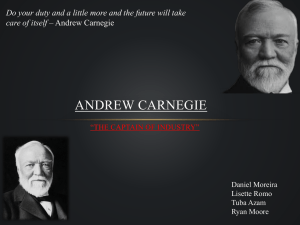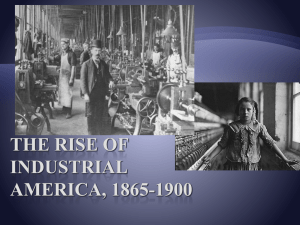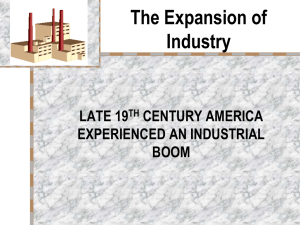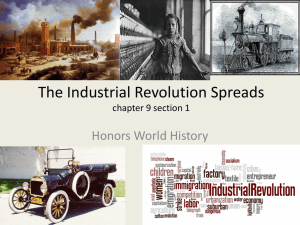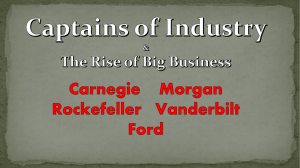Andrew Carnegie and the Steel Mills
advertisement
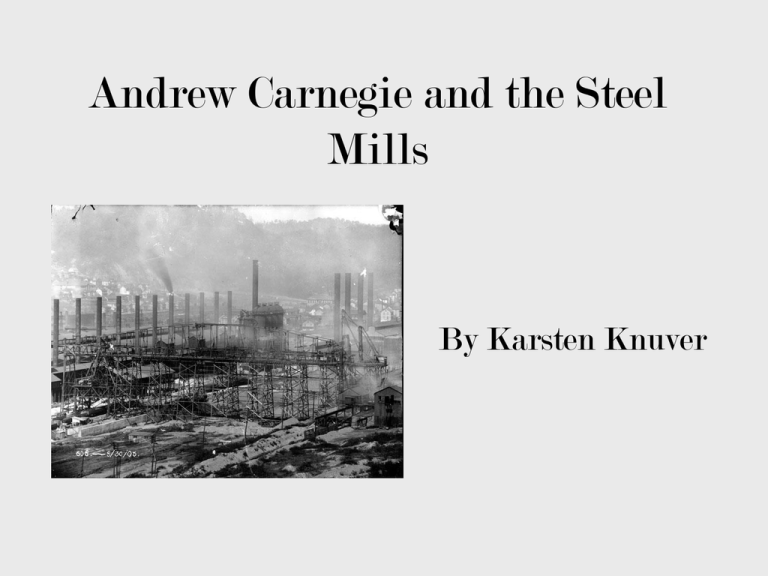
Andrew Carnegie and the Steel Mills By Karsten Knuver Summary • From 1850-1914, there were many influential men and women. But possibly the most influential person of that time was Andrew Carnegie and his steel mills. Mr. Carnegie and his mills produced massive amounts of steel, which helped America become a strong industrial nation. Andrew Carnegie and his steel mills helped America grow into the country that it is today. Andrew Carnegie • Andrew Carnegie was born on November 25, 1835, in Dunfermline, Scotland. He and his very poor parents immigrated to America when he was just 13 years old. Throughout his childhood, Mr. Carnegie had many different jobs. Andrew Carnegie • Some of them include working as a bobbin boy at a cotton factory, an engine tender, a telegraph messenger and operator, and working for Pennsylvania Railroads. He slowly worked himself up to the position of secretary/telegraph operator. Andrew Carnegie • By age 18, he started a rapid advance through the company. Soon, he was the superintendant of the Pittsburg Division of the Pennsylvania Railroads. In 1864, he invested in Storey Farm on Oil Creek in Venango County, Pennsylvania. Within a year the Farm brought in $1,000,000 in dividends. Andrew Carnegie • After the First World War, Andrew Carnegie left the railroads to focus on the production of iron and steel. He worked to develop several iron works, which eventually formed into the Keystone Bridge Company. Andrew Carnegie • However, he still continued to keep close ties with the management of Pennsylvania Railroads, Thomas A. Scott and J. Edgar Thomson. He used this connection to get contracts for Keystone Bridge Company from Pennsylvania Railroads. Andrew Carnegie • Carnegie soon controlled the most extensive iron and steel operation ever owned by someone in the United States. One of his greatest innovations which helped him create his massive operation was adapting the Bessemer process for making steel. This was a cheap and efficient way to mass produce steel. Andrew Carnegie • In 1888, he bought Homestead Steel Works, a rival extensive steel plant served by tributary coal and iron fields, a 425 mile long railway, and also a line of steamships. By 1889, his steel empire had grown to include the J. Edgar Thomson Steel Works, the Lucy Furnaces, the Union Iron Mills, the Hartman Steel works, and the Frick Coke Company, to name a few. Andrew Carnegie • In 1901, Andrew Carnegie was 66 years old and was thinking about retiring. Negotiations concluded on March 2, 1901, and the United States Steel Corporation was formed. J.P. Morgan bought Carnegie’s steel empire for $480 million, the equivalent of $13,468,800,000 today. At the time, this was the largest personal commercial transaction. Andrew Carnegie • Of this, Andrew Carnegie received $6,331,430,340 in today’s standard. After retirement, he continued his business career. He devoted himself to providing money for social and educational advancements. He founded more than 20 different organizations that supported a variety of different causes. Some of them include Carnegie Hall, in New York, the Carnegie Institution, Carnegie Hero fund, Carnegie Mellon University, and Carnegie Institution of Washington Andrew Carnegie • Carnegie spent the last years of his life as a Philanthropist. He donated much of his money to institutes and organizations. One of them includes the Tuskegee Institute, which was established by Booker T. Washington. Andrew Carnegie died on August 11, 1919, in Lenox, Massachusetts. The cause of his death was bronchial pneumonia. He had given away almost 90% of his vast fortune before his death. After he died, the remaining $30,000,000 of his wealth was given away to foundations, charities, and pensioners. Steel Making • There are 3 main raw materials used in steel making, with 9 other materials used in small amounts. Iron ore, coking coals, and scrap are the 3 main ingredients in the production of steel. Manganese and silicon are in all or most steels. In some steels there is nickel, chromium, zinc and tin. Molybdenum, vanadium, and tungsten are only minor elements used in some steel. Process of Making Steel • Three basic steps are used to make steel. First, the source of heat that is used to melt the iron ore is produced. A furnace is usually used for melting the iron ore down. After that, the iron ore is melted down in the furnace. Finally, the molten iron is processed to produce steel. All three of these steps can be done at one facility, but the fuel source is quite frequently purchased from an offsite producer. Steel Uses • In the 1900s steel was a very important resource. This is because it was used in so many different ways. For example, steel was used in railways, roads, buildings, medical equipment, car bodies, pipelines, farm machinery, quarry equipment, and walkways. Steel Mill Worker Conditions • The worker’s lives in steel mills were grueling. They had to work twelve hours a day, 7 days a week. The only day Andrew Carnegie gave his workers off was the fourth of July. The rest of the year they worked. One worker said that he lost forty pounds in three months after working in Carnegie’s steel mills. Workers had hardly any time off during the work day. Most of the steel workers didn’t have any time to eat, so they simply didn’t eat lunch. Steel Mill Worker Conditions • The only time the workers stopped for anything was to oil the engine, which only took three to five minutes to complete. On top of the long work days, the job itself was also taxing. Molten iron, dangerous machines, and the scorching air are just some of the conditions that the steel workers had to endure. But eventually, the steel workers had enough and formed a union. They demanded shorter hours, safer conditions, and more money for their dangerous work. They finally got what they wanted, and conditions improved immensely. Closing • Throughout most of the period of US Growing and Developing, Andrew Carnegie had a profound impact. He and his steel mills produced massive amounts of steel to help the United States become an industrialized nation; setting up America to become a worldwide powerhouse. He made massive amounts of money, but he didn’t keep it all for himself. At the time of his death, he had given approximately 90% of all his wealth away. Closing • He donated it to organizations, institutions, and groups that needed it most. Mr. Carnegie donated money to found Carnegie Hall, which to this day still provides New York with a stage for famous musicians from allmover the world to play on. Without Andrew Carnegie, none of this would have happened. America would very well probably not be at where it is today. Closing • Had it not been for Andrew Carnegie, America would be a very different place than it is today. We should all thank Andrew for his contributions to America and to humanity as a whole, especially to the United States. Andrew Carnegie helped America Grow and Develop from 1860-1910 to the nation that it is today. Work Cited • Encyclopedia Britannica, Volume 4, Andrew Carnegie, page 930 • United States History, Holt, Rinehart and Winston, 2007, Section 2 Big Business, page 620 • Andrew Carnegie, http://en.wikipedia.org/wiki/Andrew_Carnegie • Andrew Carnegie, http://www.history.com/topics/andrewcarnegie • Steel Making, http://www.oecd.org/industry/ind/47858288.pdf • Steel Making, http://www.istc.illinois.edu/info/library_docs/manuals/primmet als/chapter2.htm Work Cited • Steel Uses, http://www.ask.com/question/what-is-steel-used-for • Steel Uses, http://www.steeluniversity.org/content/html/eng/default.asp?cati d=2&pageid=-424514437 • Steel Production, http://www.steel.org/About%20AISI/Statistics.aspx • Steel Mill Worker Conditions, http://www.pbs.org/wgbh/amex/carnegie/sfeature/mf_steelworke r.html • Steel Mill Worker Conditions, http://www.jaha.org/edu/discovery_center/work/img/conditions/i ndex.html • Steel Mill Worker Conditions, http://www.asbestos.com/occupations/steel-mill-workers.php
![men_who_built_america[1]](http://s2.studylib.net/store/data/005219845_1-7979604da89ac700f7913bb56611cc41-300x300.png)
